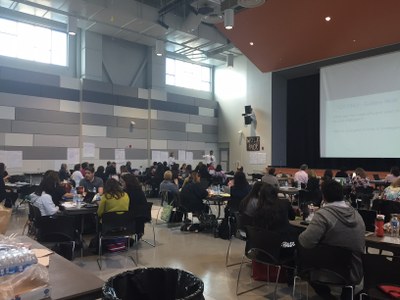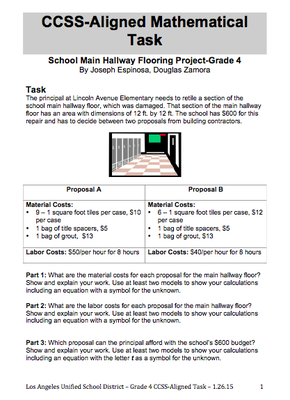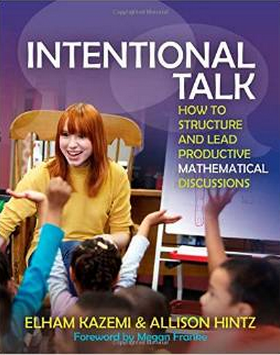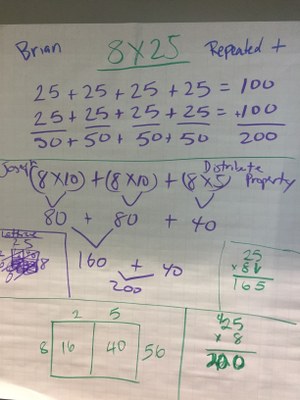LAUSD Common Core Math Fellowship
Overview
 The LAUSD Common Core Math Fellowship was created to provide teachers with the opportunity to develop their understanding of the Common Core State Standards in Mathematics (CCSSM) while building a viable professional learning network across the district that promotes collaboration, leadership, and continual learning. Instructional coaches, content experts, coordinators and other non-classroom teacher leaders also participate. Because of my role as a teacher educator, specifically as a Common Core Math Expert in LAUSD, I considered my own professional growth on a continuous basis in knowing the CCSSM and the pedagogical skills needed to effectively teach mathematics vital for supporting teachers in their own journey of effectively implementing the CCSSM. Therefore I applied and was accepted to be a LAUSD CCSS Math Fellow.
The LAUSD Common Core Math Fellowship was created to provide teachers with the opportunity to develop their understanding of the Common Core State Standards in Mathematics (CCSSM) while building a viable professional learning network across the district that promotes collaboration, leadership, and continual learning. Instructional coaches, content experts, coordinators and other non-classroom teacher leaders also participate. Because of my role as a teacher educator, specifically as a Common Core Math Expert in LAUSD, I considered my own professional growth on a continuous basis in knowing the CCSSM and the pedagogical skills needed to effectively teach mathematics vital for supporting teachers in their own journey of effectively implementing the CCSSM. Therefore I applied and was accepted to be a LAUSD CCSS Math Fellow.
I participated in the Elementary CCSS Math Fellowship Program in the Fall of 2014 and in again in the Spring of 2015. I attended the kick-off and wrap-up sessions for the fellowships in each semester and completed all the work required to complete each fellowship. In the Fall of 2014 I designed a CCSS Math Lesson with another LAUSD CCSS Math Fellow based on a math task I designed previously and in the Spring of 2015 I read the book Intentional Talk by Elham Kazemi and Allison Hintz which along with some other research led to my development of teacher tools to support their implementation of math instructional activities. As part of the requirement of the fellowship I also completed two WestEd online courses on the CCSSM domain of Operations and Algebraic Thinking (K-5) and Expression and Equation (6-8).
Developing an Exemplar CCSS Aligned Math Task Lesson (Fall 2014)
 For the Fall 2014 LAUSD CCSS Math Fellowship one of the main goals was to create CCSS aligned math tasks and lessons for possible inclusion with next year’s district math curriculum maps with a team in order to build a professional learning network. During two face-to-face meetings I learned how to use the EQuIP Rubric for Lesson & Units in the content area of mathematics to assess a math lesson for deep alignment with the CCSS, key shifts in the CCSS, and instructional supports. Moreover I also learned how to use the EQuIP Student Work Protocol to analyze a CCSS aligned task and lesson as well as the student work produced from that designed or selected lesson.
For the Fall 2014 LAUSD CCSS Math Fellowship one of the main goals was to create CCSS aligned math tasks and lessons for possible inclusion with next year’s district math curriculum maps with a team in order to build a professional learning network. During two face-to-face meetings I learned how to use the EQuIP Rubric for Lesson & Units in the content area of mathematics to assess a math lesson for deep alignment with the CCSS, key shifts in the CCSS, and instructional supports. Moreover I also learned how to use the EQuIP Student Work Protocol to analyze a CCSS aligned task and lesson as well as the student work produced from that designed or selected lesson.
In the kick-off face-to-face meeting, I decided to join another fellow who had decided to design or modify a math task and create a CCSS aligned math lesson for the fourth grade. I shared a fourth grade task that I had designed the previous year called the Kitchen Flooring Project Task, which I had used with great success along with the CA Math Framework to build teacher’s content knowledge in the domains of Operations and Algebraic and Numbers in Base Ten that previous spring during a professional development. I pitched this as a task we could use to create a CCSS aligned math lesson. One other member liked the task and joined me and we formed a team. Based on his suggestion I changed the context from tiling a kitchen floor to tiling a hallway at an elementary school and together we wrote up the lesson plan using the Thinking Through the Lesson Protocol (Smith, Bill, & Hughes, 2008). He then field tested the 4th Grade CCSS aligned math lesson at his school and collected some student work for our wrap up session.
At the wrap-up face-to-face meeting we submitted our fourth grade CCSS aligned math task and lesson along with student work to be analyzed by another grade level team. We also analyzed the CCSS aligned math task and lesson, and student work for the 5th grade team. The outcome for this process was to suggest improvements developers might make to the task, instructional context, supporting materials and/or scoring guides/rubrics. We provided this feedback to the 5th grade team and we received feedback on our CCSS aligned math task and lesson. Based on this feedback I made some important changes to address support for English Language Learners and my teammate submitted our student work based on the task.
Teaching Tools to Support Teaching Implementation of Math Instructional Activities (Spring 2015)
 For the Spring 2015 LAUSD CCSS Math Fellowship two of the main goals were to change classroom practice to reflect the CCSS Content and Practice Standards and to build leadership capacity at the site. Each fellow was asked to submit a personal professional learning plan and I decided to do book study using the book Intentional Talk: How to Structure and Lead Productive Mathematical Discussions by Elham Kazemi and Allison Hintz. This book would ground my achieving of the goals mentioned above through providing professional learning experiences to several of my schools. During both face-to-face meetings the facilitator modeled two number strings and we participated and debriefed them as well. This provided a deeper understanding for me in how to model these strings, but nonetheless I knew that modeling would not be enough for teaching to successfully implement number strings in their own classrooms.
For the Spring 2015 LAUSD CCSS Math Fellowship two of the main goals were to change classroom practice to reflect the CCSS Content and Practice Standards and to build leadership capacity at the site. Each fellow was asked to submit a personal professional learning plan and I decided to do book study using the book Intentional Talk: How to Structure and Lead Productive Mathematical Discussions by Elham Kazemi and Allison Hintz. This book would ground my achieving of the goals mentioned above through providing professional learning experiences to several of my schools. During both face-to-face meetings the facilitator modeled two number strings and we participated and debriefed them as well. This provided a deeper understanding for me in how to model these strings, but nonetheless I knew that modeling would not be enough for teaching to successfully implement number strings in their own classrooms.
I read the entire book Intentional Talk over several weeks. The book has 8 chapters with an introduction, one chapter on open strategy sharing discussions, five chapters on targeted sharing discussions of different types with different purposes, and a conclusion. In part the book was a result of the Learning In, From, and For Teaching Practice (LTP) project funded by the Spencer Foundation and based on research at UCLA, the University of Washington, the University of Michigan, and the University of Wisconsin-Madison. This research related to LTP also influenced my inclusion of teaching tools such as teaching protocols and checklists.
During the four week fellowship, I co-planned and co-facilitated two professional development sessions at  one of my elementary schools on the topic of Number Talks together with the instructional coach. This was part of a series in engaging students with the Standards for Mathematical Practice (#1, #3, #7 and #8) while also supporting teachers with CCSS Instructional Shift # 3 on Rigor (Procedural Skill and Fluency). During the first session I modeled both of the strings I had participated in at the kickoff fellowship meeting. For each professional learning experience a rehearsal is provided for teachers to rehearse number strings with their colleagues. I provided the protocol for teaching number strings from the appendix of the book and planned with the teacher who volunteered to teach the number string to their colleagues, who all pretend to be students in their own classrooms. I offer in the moment coaching support during this rehearsal for the teacher facilitating the number string. I also created a protocol for another kind of number talk, choral counting, which I provided to teachers when they rehearsed choral counting with their colleagues in a small group. Finally in the second Number Talks session, teachers were provided with an overview and description of the planning discussion templates for open strategy and targeted discussions as well as which number talks might best be served by the open strategy and targeted discussions. This new learning was directly from the book.
one of my elementary schools on the topic of Number Talks together with the instructional coach. This was part of a series in engaging students with the Standards for Mathematical Practice (#1, #3, #7 and #8) while also supporting teachers with CCSS Instructional Shift # 3 on Rigor (Procedural Skill and Fluency). During the first session I modeled both of the strings I had participated in at the kickoff fellowship meeting. For each professional learning experience a rehearsal is provided for teachers to rehearse number strings with their colleagues. I provided the protocol for teaching number strings from the appendix of the book and planned with the teacher who volunteered to teach the number string to their colleagues, who all pretend to be students in their own classrooms. I offer in the moment coaching support during this rehearsal for the teacher facilitating the number string. I also created a protocol for another kind of number talk, choral counting, which I provided to teachers when they rehearsed choral counting with their colleagues in a small group. Finally in the second Number Talks session, teachers were provided with an overview and description of the planning discussion templates for open strategy and targeted discussions as well as which number talks might best be served by the open strategy and targeted discussions. This new learning was directly from the book.
In the Spring of 2015 I designed and facilitated a number string study cycle for grades K-6 at one of the elementary schools I served during their psychomotor meeting whereby we co-planned a number string, co-taught that number string as a group, and debriefed using a modified Lesson Study discussion protocol. A month later I facilitated number string study cycles for grade K-6 at another elementary school I support. This experience was intentionally designed to provide teachers with implementation support and feedback through cognitively co-planning a number string, provided teaching tools, and in the moment coaching feedback so they would adopt this instructional activity as a daily math warm-up. This experience included having teachers use teaching tools in the form of a teaching protocol for number strings from the book, Intentional Talk, and a number strings checklist I created which mirrored the protocol. The number strings checklist was used after the co-teaching experience along with an observation script recorded by the instructional coach during the rehearsal as two pieces of data to inform the debrief of the rehearsal. This sixty-minute experience was highly successful in providing teachers with a clearer idea of the essential components of a number string because the protocol made these components explicit and they used the checklist as a reminder of what to remember to do when teaching number strings. Moreover during the rehearsal I provided in the moment corrective feedback and after the rehearsal teachers checked off the number string components we completed. This is characteristic of the adult learning theory cognitive apprenticeship
CAPEs Connections
CAPE 5: Promoting Implementation of the K-12 Standards, Pedagogical Skills, Effective Instructional Practice
Through my own learning in reading Intentional Talk I was able to understand and articulate the essential components in teaching numbers strings with the purpose of building students’ computational fluency and a deeper understanding of mathematical operations. Moreover this translates into successful student learning when teachers use specific instructional practices such as talks moves within open and targeted strategy discussions. In the professional development sessions on Number Talks I modeled these instructional practices during a demonstration of a number string and ways to make a number. I promoted number strings as an effective instructional activity for addressing both the Common Core Math Content and Practice standards. Thus this work connects to and addresses several aspects of CAPE 5.
CAPE 13: Modeling Life-Long Learning and Job-Related Professional Growth
During the course of this fellowship and based on my learning I made several changes to the design of the professional development sessions I provided at one of the elementary schools I supported. For example I redesigned the rehearsal of each number talk so that the volunteer had an opportunity co-plan with me first before teaching the number talk to the other teachers. Another example is in my use of the number string teaching protocol and checklist to break down the number string instructional activity into its essential parts, thus supporting my modeling of number strings and teachers’ rehearsals. Teacher feedback for the number talks professional development sessions at the second elementary school in which I facilitated these two sessions was better than the feedback from my initial attempts and was due in part to specific changes I made in the design of the learning experience for teachers based on my new learning from reading the book and the research behind it. Thus this work connects to and addresses aspects of CAPE 13.
CAPE 15: Identifying and Facilitating a Variety of Professional and Personal Growth Opportunities for Faculty, Staff, Parents, and Other Members of the School Community in Support of the Educational Program
For both the whole school Number Talks PDs I co-planned and co-facilitated with the instructional coaches to involve them in providing focused professional development. Moreover I asked the instructional coaches at both elementary schools I support to help in scripting the rehearsals in order to provide teachers with a record of our learning as we sought together to improve in teaching math using number strings. Because I knew that teachers would be more likely to implement number strings on a daily basis in their classroom if they were provided with the instructional materials I sought to communicate with the instructional coaches and principals of the two elementary schools I supported to provide these materials with any funds they might use for this purpose. Both schools purchased number string instructional materials for each teacher according to their grade level. I provided teaching supports in terms of teaching protocols, teaching checklists, and a number talk lesson planner, which encouraged cognitive planning. Thus this work connects to and addresses aspects of CAPE 15.
Reflection
My roles included:
- Instructional leader in supporting teachers and instructional coaches ing understanding and effectively implementing the Common Core Math Content and Practice Standards using principles and practices of effective instruction and appropriate pedagogical skills for mathematics.
- Life-long learner who continuously seek out professional learning opportunities and feedback to improve professionally.
- Collaborative leader of professional development who involves others in designing and facilitating professional learning experiences to support an increase in adults’ knowledge and skills as well as student achievement.
One challenge in having teachers use checklists based on teaching protocols was that I did not have time to explain why this is important. I was able to explain the various purposes within the professional learning experience for the number string protocol as an explicit representation of the instructional activity but the impetus for using checklists as a teaching tools came from my own knowledge of the use of checklists to standardize a process as described by Atul Giwande in his book Checklist Manifesto.
Teacher feedback was positive with several teachers teaching the number strings we had rehearsed together in their own classrooms that same day or the next day and several stating that they had a better understanding of number strings including some of the more challenging aspects of teaching this instructional activity. Moreover several teachers shared new insights about using representations to model student thinking and on how to record student thinking.
With respect to participating in a book study, next time I would seek to read the book together with the instructional coaches I collaborate with or create a book club with teachers. This would support all of us in have the same knowledge base, but also contribute to more insights because conversations about the book would include multiple perspectives. This could be a professional learning experience in itself and it supports the idea of building group capacity and a professional learning network, which was one of the goals of the fellowship.
Supporting Documents:
- LAUSD CCSS Math Fellowship Description and Overview Sheets
- CCSS Aligned Math Task: School Main Hallway Flooring Project
- WestEd Operations and Algebraic Thinking Certificate of Completion
- Number Strings Teaching Checklist
- Choral Counting Teaching Protocol
- WestEd Expressions and Equations Certificate of Completion

